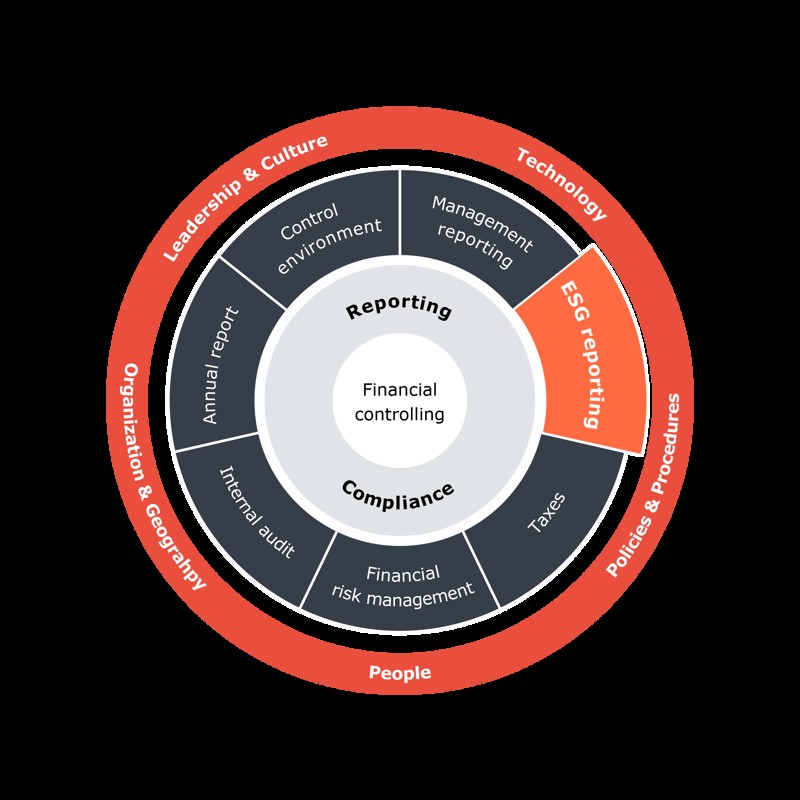A well-functioning ESG operating model is an essential tool for creating structure and direction for your company's ESG requirements – and a robust ESG accounting manual is vital in this context. This is why Finance plays a central role in your company's sustainability and compliance activities. In this article, you can read about the CFO's key focus areas on the path towards an effective and reliable ESG accounting manual.
With increasing requirements for ESG reporting, building a robust ESG operating model has become crucial. This is an operating model that requires structured processes for data collection, controlling and consolidation, which can be adapted to both current and future requirements.
And here, the CFO and Finance play a central role in ensuring that the company's ESG objectives are embedded in the organisation and supported by robust reporting and data processes, and that ESG data meet requirements for relevance, fair representation, comparability, verifiability and comprehensibility – frameworks described in the EU's CSRD directive, and which we also recognise from financial data.
Based on the CSRD and ESRS standards, ESG information must be divided into key sections (general information, environment, social responsibility and business conduct) and integrated into the annual report. The Finance department's experience with statutory reporting and control makes it the obvious function to ensure that ESG reporting complies with regulatory requirements and quality standards.
A cross-organisational task
Though responsibility for the quantitative part of ESG reporting should be anchored in Finance, this does not mean that all tasks regarding data collection controls necessarily need to be performed in Finance.
For example, the responsibility for employee data rests with HR, but is reported to Finance as part of either ongoing or annual reporting. The same principle applies to ESG data, where the responsibility for the relevant data is placed where the data originate. Thus, production, facility management or similar departments are responsible for waste data, diversity or water, heating and energy for CO2 calculations, for instance. However, Finance should take responsibility for ensuring that ESG data in reporting are accurate and correct, as they possess the necessary skills to structure data and ensure quality through controls.
Thus, the ESG operating model becomes a cross-organisational and coherent model. Here, the CFO and Finance are the key actors in ensuring that it not only meets current requirements, but is also sufficiently scalable and robust to adapt to later standards and expectations, so that ESG reporting meets the requirements for quality, reliability and transparency – and thereby the overall requirements for the company's compliance.
The ESG accounting manual as an operational link
An ESG operating model functions as a framework that, based on the double materiality assessment, creates structure and clearly defined roles and responsibilities for the company's handling of ESG requirements. This is achieved by defining clear processes and areas of responsibility, thereby operationalising the tasks of collecting, quality assuring and reporting on ESG data.
A central component in the operating model is the ESG accounting manual, which functions as an operational link between reporting requirements, business and the reporting itself.
The manual defines the frameworks and processes that employees must follow in connection with data collection, data processing, quality assurance and reporting of necessary data points. By establishing a common framework across the organisation, the manual contributes to creating transparency and uniformity in reporting, whilst ensuring compliance with regulatory requirements and their timing.
The manual should include and address central elements, such as:
Framework for reporting: This section outlines the frameworks, organisation and internal documents that are relevant to understanding the overall reporting and control structure for ESG in the company. For example, here you can describe that the accounting policies and reporting scope have been developed with input from the GHG Protocol and CSRD (including ESRS) and furthermore in accordance with the EU Taxonomy and Science Based Targets Initiative (SBTI).
Estimation principles: Clear guidelines for how data are estimated when direct measurements or data are not possible and/or available to collect, as well as methods to ensure consistency and transparency in reporting across entities, countries and individuals.
KPI dictionary: Provides an overview of key KPIs to be reported in the sustainability report, along with brief descriptions of definitions, calculations and any references to relevant external documents.

The accounting manual supports risk management
A robust ESG accounting manual supports your company's task of identifying, assessing and managing risks associated with ESG data. Risk management plays a central role, as errors, deficiencies or inconsistencies in ESG data can have significant consequences for the management's ability to fulfil the ESG strategy and meet the regulatory reporting requirements.
For example, companies may encounter challenges with accurate reporting of material consumption, such as differences between procurement, inventory and actual usage. Such discrepancies can create uncertainty about the quality and reliability of the data. Here, an ESG accounting manual is central to supporting accurate, consistent and timely reporting of ESG data, whilst supporting risk management. Additionally, it reduces the need for internal controls as it minimises the inherent risk of errors.
The ESG accounting manual is also a valuable tool in collaboration with auditors. Here, a well-defined manual can contribute to a more efficient process, as it clearly describes the practices used, allowing you to focus on the message rather than practicalities. Though developing an ESG accounting manual may seem like a trivial process, it will serve as a catalyst for timely clarification of the aforementioned complexities before they potentially result in errors and inefficiency.
On the next page, you will be presented with some of the most common challenges along with recommendations on how to address them.
- Bemærk, at lovkravene for ESG-rapportering revurderes, og denne artikel er baseret på gældende lovgivning per ultimo februar 2025.
Your guide to a robust ESG accounting manual
Below, we describe some of the typical challenges that companies may encounter in the process of developing the ESG accounting manual, as well as recommendations for solving them.
Challenge
Recommendation
Lack of internal controls and governance regarding ESG data:
Data are often collected manually and without the same controls as financial data. This increases the risk of errors and omissions, which can weaken credibility.
- Implement a governance structure where ESG data undergo the same quality controls as financial data.
- Designate those responsible for collecting, validating and reporting ESG data in various departments.
- Define the placement and ownership of the control environment - centralised or decentralised.
Lack of data integration between ESG and financial processes:
ESG data are often spread across systems and teams, making it difficult to collect and integrate the data into the company's overall financial reporting.
- Invest in integrated systems that can handle both ESG and financial data.
- Ensure that ESG metrics and financial KPIs are harmonised so they can be compared and used for decision-making.
- Utilise the connection between financial and ESG data in relation to controlling thereof (reconciliations and plausibility checks, etc.), which can help ensure the completeness and accuracy of data.
Definition of KPIs and the KPI dictionary:
Many companies struggle to define clear and consistent KPIs, especially when there is a lack of standardisation between industries or internal departments. It can also be challenging to link ESG data to financial data in a meaningful way.
- Develop a clear KPI dictionary with standardised definitions, data sources and calculation methods for each KPI.
Risk of 'greenwashing' or lack of transparency:
Inadequate documentation or unclear reporting can lead to accusations of greenwashing and damage the company's credibility.
- Document all data, assumptions and calculation methods thoroughly to minimise risk and doubt about data, especially regarding estimates and approximations.
- Ensure that ESG reporting complies with relevant standards and frameworks (e.g. CSRD, ESRS).
Challenges with risk assessment and prioritisation:
Companies often lack a structured approach to assessing ESG risks, especially across the entire value chain.
- Start the double materiality assessment and ESG risk assessment in good time.
- Involve relevant departments in a cross-functional process to ensure that risks are assessed holistically and prioritised correctly.
Lack of investment in ESG data management:
Many companies expect to bring ESG data up to the level of financial data without investing in corresponding systems, processes and resources. This can result in poor data quality, inefficient reporting and thus lower credibility with stakeholders.
- Companies should recognise that ESG data require the same level of systematisation and robustness as financial data. Invest in appropriate technology and expertise to manage ESG data effectively.
- Communicate clearly to the management and the board about the necessity of allocating budget and resources for ESG reporting, especially if the ambition is to deliver credible and decision-capable ESG information.
- Once you have an overview of the company's reporting scope, assess how the task is positioned in the organisation, and consider where the right competencies and resources are found.

Shall we help you create a practically applicable ESG accounting manual?

 en
en
 da
da




